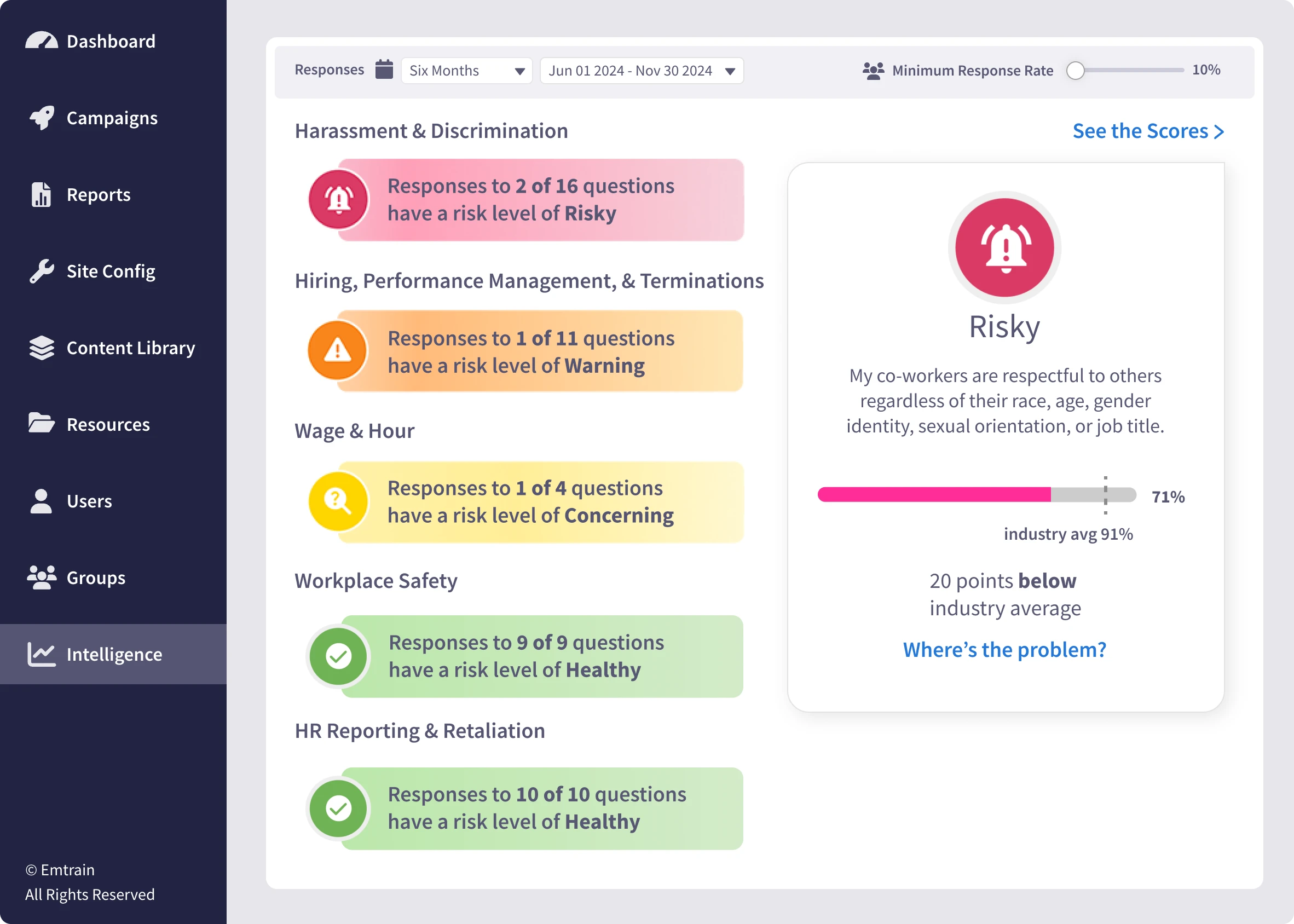Home » Concepts » Ethics & Compliance » Patents
A patent is a legal right granted to an inventor that provides exclusive control over making, using, or selling their invention for a limited time—usually 20 years from the filing date. In return, the inventor publicly discloses how the invention works, advancing innovation across industries. Patents are a form of intellectual property (IP)—alongside copyrights, trademarks, and trade secrets—that protect ideas and creations that give organizations a competitive advantage. In the workplace, patents apply to new technologies, product designs, chemical formulas, algorithms, and processes developed by employees.
As covered in Emtrain’s Intellectual Property Training, understanding patents helps every employee—from researchers to marketers—recognize what qualifies as protected IP, when to disclose inventions internally, and how to avoid accidental infringement.
Emtrain’s harassment training course is engaging, interactive, and designed to spot and reduce EEO risk.

The first patent system—established in 15th-century Venice—was created to reward innovation while preventing secrecy. The idea was simple: inventors could profit from their creations for a limited time if they shared how those inventions worked.
Over the centuries, this balance between protection and public disclosure fueled progress from the printing press to the microchip. Today, patent systems are globalized, with the World Intellectual Property Organization (WIPO) reporting more than 3.5 million filings in 2023, and the U.S. Patent and Trademark Office (USPTO) granting roughly 400,000 patents annually.
As technology evolves, new questions surface—especially around AI-generated inventions. Can an AI model be listed as an inventor? Who owns the output of automated systems? These topics are central to Emtrain’s AI Governance course, which explores the ethical and legal boundaries of modern innovation.
Intellectual property issues can arise from everyday decisions:
Sharing an idea too soon at a conference or with an AI tool
Using unlicensed images or open-source code without review
Signing a vendor contract that quietly transfers ownership rights
Even well-intentioned actions can expose organizations to risk. By recognizing IP red flags early, employees help preserve the organization’s most valuable assets—its ideas and innovations.
That’s why IP awareness is not just for lawyers. It’s a business skill that supports ethical decision-making and cross-functional trust—values at the heart of Emtrain’s 5 Steps to a Modern Code of Conduct Program.
Premature Public Disclosure
A biotech researcher shares a novel lab technique at a conference before a patent is filed. The public disclosure invalidates the patent opportunity.
Lesson: Always coordinate with Legal or Compliance before public presentations.
Unlicensed Use of Content
A marketing intern includes copyrighted music in a product video. The campaign faces takedown notices and damages claims.
Lesson: Verify all creative assets are licensed and documented.
Patent Overlap in AI Products
A developer’s new code resembles a patented process. The manager halts development and seeks legal advice.
Lesson: Proactive review prevents infringement.
Vendor IP Ownership Trap
A contract gives a vendor joint ownership of new inventions. Legal review corrects the clause to ensure company ownership.
Lesson: Always review IP clauses in third-party agreements.
Each example reinforces that IP protection starts with awareness—knowing when to pause, ask, and verify before acting.
When potential IP issues arise, respond promptly, transparently, and collaboratively:
Pause activity to prevent further exposure.
Document the facts—what was shared, when, and with whom.
Report immediately to Legal, Compliance, or your IP lead.
Educate your team so similar risks are avoided in the future.
The U.S. Small Business Administration (SBA) estimates that IP theft costs U.S. companies over $600 billion annually, while data from the European Patent Office (EPO) shows that businesses managing their IP portfolio effectively are 21% more likely to outperform peers.
A culture that normalizes raising IP concerns early prevents damage—and promotes innovation through responsible collaboration.
Understand What Counts as IP
Patents, copyrights, trademarks, trade secrets—all deserve protection and respect.
Protect Confidential Information
Use NDAs, secure files, and share only through approved channels.
Consult Before Disclosing
Always check with Legal or Compliance before publishing or presenting innovation-related work.
Use Authorized Tools and Materials
Confirm software, data, and media are licensed for use.
Promote Ethical AI Practices
As covered in Emtrain’s AI Governance program, transparency and bias awareness are essential in AI-driven innovation.
Conduct IP audits annually to identify assets and renewal needs.
Train all employees on IP basics and reporting procedures.
Recognize inventors internally to encourage disclosure and engagement.
Use NDAs consistently with vendors and partners.
Align IP protection with broader ethics and compliance goals.
When IP protection becomes a shared value, organizations innovate with confidence and integrity.
Safeguarding intellectual property is more than protecting patents—it’s about protecting the ideas and people behind them. Every time an employee pauses to confirm a license, flags a potential overlap, or checks a contract clause, they’re reinforcing trust and accountability across the organization.
Patents are the bridge between innovation and integrity—a legal tool that ensures great ideas benefit their rightful creators. By understanding how patents work and how to handle IP responsibly, employees help build organizations where creativity and ethics thrive together.
To strengthen your team’s understanding, explore Emtrain’s Intellectual Property Training and learn practical ways to protect your company’s most valuable asset—its ideas.
Scenario: Overlapping AI Innovation and Patent Concerns
A software engineer proudly unveils a new AI tool that automates data insights. As the team reviews the system, the manager realizes the product resembles a competitor’s patented design. Rather than dismissing the concern, the manager halts progress and recommends consulting Legal before moving forward.
This proactive step prevents potential patent infringement and reinforces a culture where speaking up early protects innovation. The message is clear: IP protection is everyone’s job.